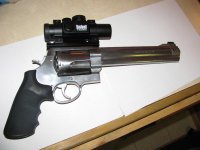I'm pretty sure the differences in comp's is about fouling problems using lead with the jacketed type brake. (I could be wrong.)
I'm using a touch over 50grains of H110 behind 200 grain jacketed bullets, they sure are zippy.
The muzzle brakes are great, it my first gun that has one and I am impressed with how well they work.
.............
So I remain perplexed by the two breaks on the 460 xvr. It seems like there surely is a reason other than ease of maintenance/cleaning. Can anyone tell me the difference. Surely SW wouldn't engineer two for the sole purpose of cleaning........Thoughts
The jacketed comp has holes projecting up and which go out the comp and the shroud.
The lead comp does not have these and is extended with two addition side ports.
If you use the jacketed comp port shooting lead and lead accumulates in the top ports it makes extracting the comp extremely difficult and occasionally next to impossible.
Some find the lead comp reduces muzzle flip better than the jacketed comp.
Be safe
Ruggy


